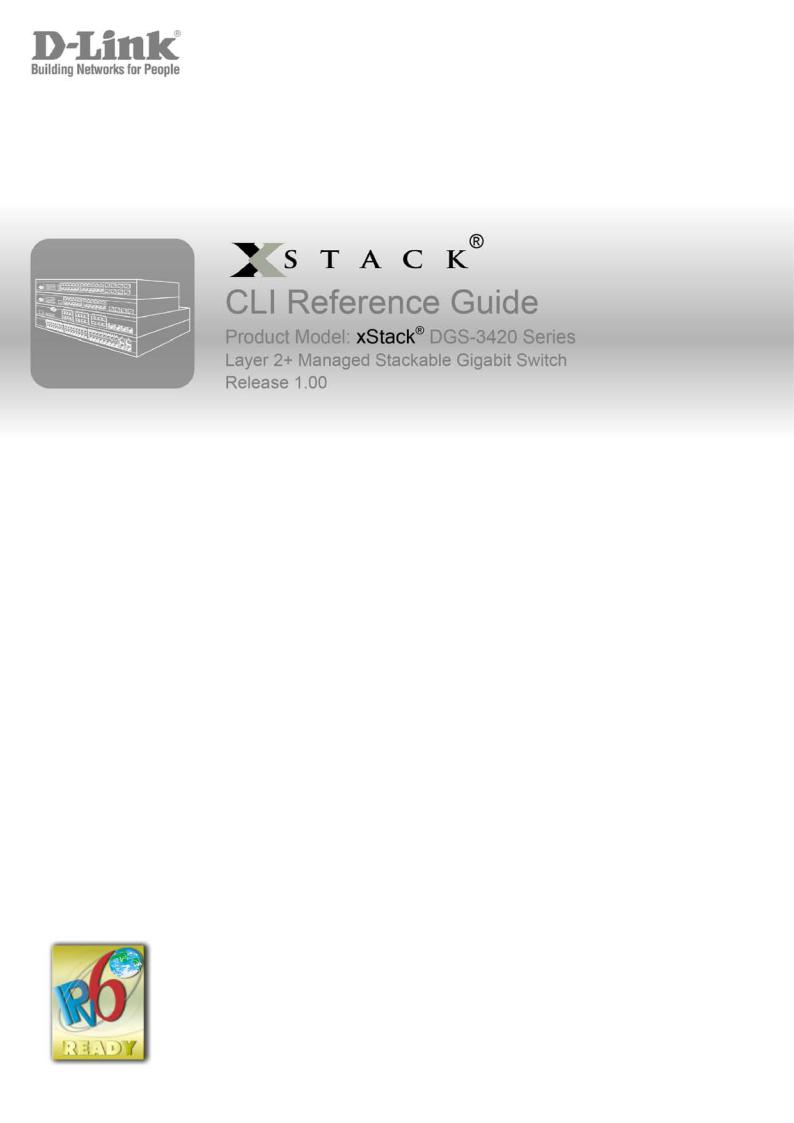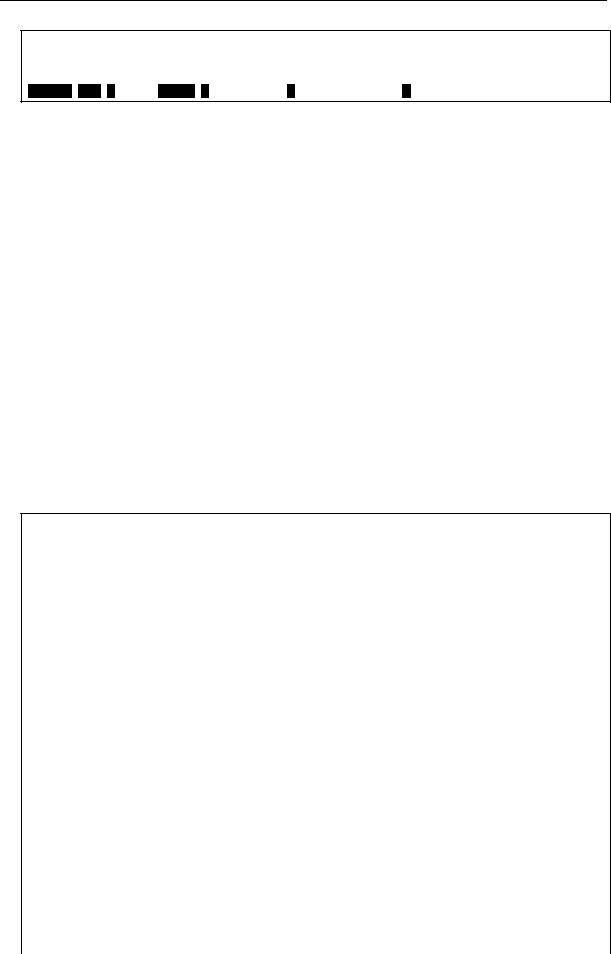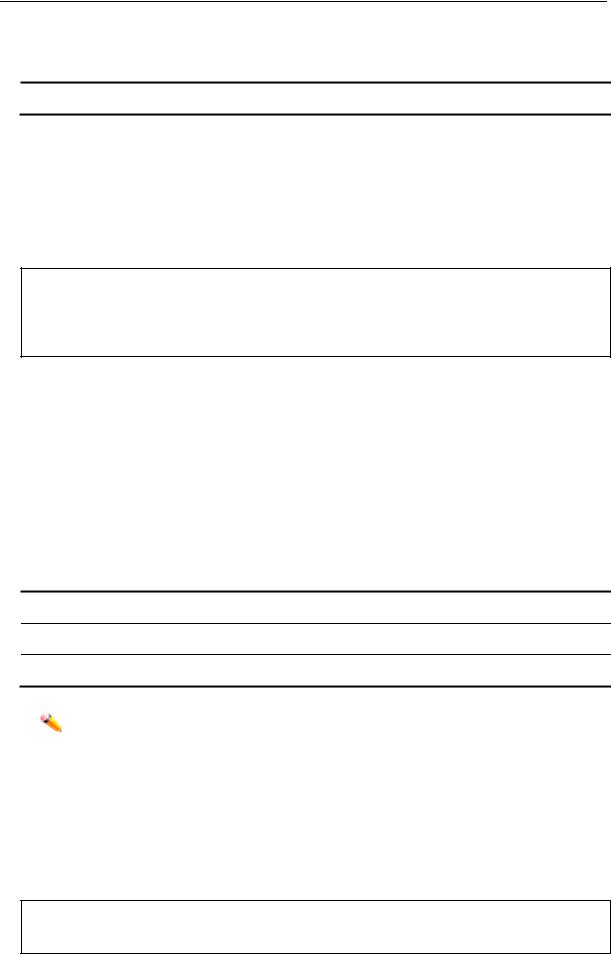D-Link dgs-3420 User Manual


xStack® DGS-3420 Series Layer 2 Managed Stackable Gigabit Switch CLI Reference Guide
|
Table of Contents |
|
Chapter 1 Using Command Line Interface........................................................................................... |
1 |
|
Chapter 2 Basic Management Commands .......................................................................................... |
8 |
|
Chapter 3 |
802.1X Commands............................................................................................................ |
30 |
Chapter 4 Access Authentication Control (AAC) Commands............................................................ |
56 |
|
Chapter 5 Access Control List (ACL) Commands.............................................................................. |
78 |
|
Chapter 6 Access Control List (ACL) Egress Command List .......................................................... |
107 |
|
Chapter 7 |
ARP Commands.............................................................................................................. |
126 |
Chapter 8 ARP Spoofing Prevention Commands............................................................................ |
131 |
|
Chapter 9 Asymmetric VLAN Commands........................................................................................ |
133 |
|
Chapter 10 Auto Configuration Commands ................................................................................... |
135 |
|
Chapter 11 Basic IP Commands.................................................................................................... |
138 |
|
Chapter 12 BPDU Attack Protection Commands........................................................................... |
147 |
|
Chapter 13 Cable Diagnostics Commands.................................................................................... |
152 |
|
Chapter 14 |
CFM Commands ......................................................................................................... |
155 |
Chapter 15 Command List History Commands ............................................................................. |
182 |
|
Chapter 16 Command Logging Command List.............................................................................. |
185 |
|
Chapter 17 Common Unicast Routing Command List................................................................... |
187 |
|
Chapter 18 Compound Authentication Commands ....................................................................... |
193 |
|
Chapter 19 Debug Software Command List .................................................................................. |
203 |
|
Chapter 20 DHCP Local Relay Commands................................................................................... |
229 |
|
Chapter 21 DHCP Relay Commands ............................................................................................ |
233 |
|
Chapter 22 DHCP Server Commands ........................................................................................... |
248 |
|
Chapter 23 DHCPv6 Relay Command List.................................................................................... |
274 |
|
Chapter 24 DHCPv6 Server Commands ....................................................................................... |
279 |
|
Chapter 25 Domain Name System (DNS) Relay Commands ....................................................... |
293 |
|
Chapter 26 Domain Name System (DNS) Resolver Commands .................................................. |
298 |
|
Chapter 27 DoS Attack Prevention Commands............................................................................. |
305 |
|
Chapter 28 D-Link Unidirectional Link Detection (DULD) Commands .......................................... |
310 |
|
Chapter 29 Ethernet Ring Protection Switching (ERPS) Commands............................................ |
312 |
|
Chapter 30 |
External Alarm Commands ......................................................................................... |
322 |
Chapter 31 |
FDB Commands.......................................................................................................... |
324 |
Chapter 32 File System Management Commands........................................................................ |
333 |
|
Chapter 33 |
Filter Commands......................................................................................................... |
343 |
Chapter 34 Gratuitous ARP Commands........................................................................................ |
350 |
|
|
II |
|

xStack® DGS-3420 Series Layer 2 Managed Stackable Gigabit Switch CLI Reference Guide
Chapter 35 IGMP Proxy Commands ............................................................................................. |
355 |
|
Chapter 36 IGMP Snooping Commands ....................................................................................... |
360 |
|
Chapter 37 IGMP Snooping Multicast (ISM) VLAN Commands.................................................... |
381 |
|
Chapter 38 IP Routing Commands ................................................................................................ |
392 |
|
Chapter 39 IP Tunnel Commands ................................................................................................. |
397 |
|
Chapter 40 IPv6 NDP Commands ................................................................................................. |
406 |
|
Chapter 41 IP-MAC-Port Binding (IMPB) Commands ................................................................... |
413 |
|
Chapter 42 Japanese Web-based Access Control (JWAC) Commands....................................... |
434 |
|
Chapter 43 Jumbo Frame Commands........................................................................................... |
458 |
|
Chapter 44 LACP Configuration Commands ................................................................................. |
461 |
|
Chapter 45 Layer 2 Protocol Tunneling (L2PT) Command List..................................................... |
463 |
|
Chapter 46 Limited Multicast IP Address Commands ................................................................... |
468 |
|
Chapter 47 Link Aggregation Commands...................................................................................... |
477 |
|
Chapter 48 |
LLDP Commands........................................................................................................ |
482 |
Chapter 49 Loopback Detection Commands ................................................................................. |
505 |
|
Chapter 50 Loopback Interface Commands .................................................................................. |
512 |
|
Chapter 51 MAC Notification Commands ...................................................................................... |
515 |
|
Chapter 52 MAC-based Access Control Commands .................................................................... |
520 |
|
Chapter 53 |
Mirror Commands........................................................................................................ |
536 |
Chapter 54 MLD Proxy Commands ............................................................................................... |
542 |
|
Chapter 55 MLD Snooping Commands ......................................................................................... |
547 |
|
Chapter 56 MLD Snooping Multicast (MSM) VLAN Commands ................................................... |
566 |
|
Chapter 57 Modify Login Banner and Prompt Commands ............................................................ |
577 |
|
Chapter 58 Network Load Balancing (NLB) Commands ............................................................... |
581 |
|
Chapter 59 Network Management Commands.............................................................................. |
585 |
|
Chapter 60 Network Monitoring Commands.................................................................................. |
602 |
|
Chapter 61 |
OAM Commands......................................................................................................... |
620 |
Chapter 62 Packet Storm Commands ........................................................................................... |
627 |
|
Chapter 63 Password Recovery Commands................................................................................. |
632 |
|
Chapter 64 Port Security Commands ............................................................................................ |
635 |
|
Chapter 65 Power over Ethernet (PoE) Commands...................................................................... |
643 |
|
Chapter 66 Power Saving Commands........................................................................................... |
648 |
|
Chapter 67 Precision Time Protocol (PTP) Commands ................................................................ |
650 |
|
Chapter 68 Protocol VLAN Commands ......................................................................................... |
668 |
|
Chapter 69 |
QoS Commands.......................................................................................................... |
674 |
Chapter 70 |
Q-in-Q Command........................................................................................................ |
688 |
|
III |
|

xStack® DGS-3420 Series Layer 2 Managed Stackable Gigabit Switch CLI Reference Guide
Chapter 71 |
Routing Information Protocol (RIP) Command List..................................................... |
696 |
Chapter 72 |
RIPng Commands....................................................................................................... |
701 |
Chapter 73 |
RSPAN Commands..................................................................................................... |
705 |
Chapter 74 |
Safeguard Engine Commands .................................................................................... |
711 |
Chapter 75 |
sFlow Commands........................................................................................................ |
713 |
Chapter 76 |
Single IP Management Commands ............................................................................ |
724 |
Chapter 77 |
SMTP Commands....................................................................................................... |
734 |
Chapter 78 |
SNMPv1/v2/v3 Commands ......................................................................................... |
739 |
Chapter 79 |
Spanning Tree Protocol (STP) commands ................................................................. |
756 |
Chapter 80 |
SSH Commands.......................................................................................................... |
769 |
Chapter 81 |
SSL Commands .......................................................................................................... |
777 |
Chapter 82 |
Stacking Commands ................................................................................................... |
783 |
Chapter 83 |
Static MAC-based VLAN Commands ......................................................................... |
790 |
Chapter 84 |
Static Replication Commands ..................................................................................... |
793 |
Chapter 85 |
Subnet VLAN Commands ........................................................................................... |
800 |
Chapter 86 |
Switch Port Commands............................................................................................... |
806 |
Chapter 87 |
System Severity Commands....................................................................................... |
810 |
Chapter 88 |
Tech Support Commands ........................................................................................... |
812 |
Chapter 89 |
Time and SNTP Commands ....................................................................................... |
815 |
Chapter 90 |
Traffic Segmentation Commands................................................................................ |
822 |
Chapter 91 |
UDP Helper Commands.............................................................................................. |
824 |
Chapter 92 |
Utility Commands ........................................................................................................ |
830 |
Chapter 93 |
Voice VLAN Commands ............................................................................................. |
853 |
Chapter 94 |
VLAN Commands........................................................................................................ |
863 |
Chapter 95 |
VLAN Trunking Commands ........................................................................................ |
880 |
Chapter 96 |
Web-based Access Control (WAC) Commands ......................................................... |
884 |
Appendix A |
Mitigating ARP Spoofing Attacks Using Packet Content ACL .................................... |
898 |
Appendix B |
Password Recovery Procedure................................................................................... |
906 |
Appendix C |
System Log Entries ..................................................................................................... |
908 |
Appendix D |
Trap Entries................................................................................................................. |
927 |
Appendix E |
RADIUS Attributes Assignment................................................................................... |
931 |
IV

xStack® DGS-3420 Series Layer 2 Managed Stackable Gigabit Switch CLI Reference Guide
Chapter 1 Using Command Line
Interface
The DGS-3420 Layer 2+ stackable Gigabit Ethernet switch series are members of the D-Link xStack® family. Ranging from 10/100/1000Mbps edge switches to core gigabit switches, the xStack® switch family has been future-proof designed to provide a stacking architecture with fault tolerance, flexibility, port density, robust security and maximum throughput with a user-friendly management interface for the networking professional.
The Switch can be managed through the Switch’s serial port, Telnet, SNMP or the Web-based management agent. The Command Line Interface (CLI) can be used to configure and manage the Switch via the serial port or Telnet interfaces.
This manual provides a reference for all of the commands contained in the CLI. Every command will be introduced in terms of purpose, format, description, parameters, and examples. Configuration and management of the Switch via the Web-based management agent are discussed in the Web UI Reference Guide. For detailed information on installing hardware please also refer to the Harware Installation Guide.
1-1 Accessing the Switch via the Serial Port
The Switch’s serial port’s default settings are as follows:
•115200 baud
•no parity
•8 data bits
•1 stop bit
A computer running a terminal emulation program capable of emulating a VT-100 terminal and a serial port configured as above is then connected to the Switch’s serial port via an RJ-45 to RS232 DB-9 convertor cable.
With the serial port properly connected to a management computer, the following screen should be visible.
DGS-3420-28SC Gigabit Ethernet Switch
Command Line Interface
Firmware: Build 1.00.024
Copyright(C) 2011 D-Link Corporation. All rights reserved.
UserName:
There is no initial username or password. Just press the Enter key twice to display the CLI input cursor − DGS-3420-28SC:admin#. This is the command line where all commands are input.
1

xStack® DGS-3420 Series Layer 2 Managed Stackable Gigabit Switch CLI Reference Guide
1-2 Setting the Switch’s IP Address
Each Switch must be assigned its own IP Address, which is used for communication with an SNMP network manager or other TCP/IP application (for example BOOTP, TFTP). The Switch’s default IP address is 10.90.90.90. You can change the default Switch IP address to meet the specification of your networking address scheme.
The Switch is also assigned a unique MAC address by the factory. This MAC address cannot be changed, and can be found on the initial boot console screen – shown below.
Boot Procedure |
V1.00.006 |
-------------------------------------------------------------------------------
Power On Self |
Test ........................................ |
100 |
% |
MAC Address |
: 00-01-02-03-04-00 |
|
|
H/W Version |
: A1 |
|
|
Please Wait, Loading V1.00.024 Runtime Image .............. |
100 |
% |
|
UART init ................................................. |
|
100 |
% |
Starting runtime image |
|
|
|
Device Discovery .......................................... |
100 |
% |
|
Configuration |
init ........................................ |
100 |
% |
The Switch’s MAC address can also be found in the Web management program on the Device Information (Basic Settings) window on the Configuration menu.
The IP address for the Switch must be set before it can be managed with the Web-based manager. The Switch IP address can be automatically set using BOOTP or DHCP protocols, in which case the actual address assigned to the Switch must be known.
Starting at the command line prompt, enter the commands config ipif System ipaddress xxx.xxx.xxx.xxx/yyy.yyy.yyy.yyy. Where the x’s represent the IP address to be assigned to the IP interface named System and the y’s represent the corresponding subnet mask.
Alternatively, you can enter config ipif System ipaddress xxx.xxx.xxx.xxx/z. Where the x’s represent the IP address to be assigned to the IP interface named System and the z represents the corresponding number of subnets in CIDR notation.
The IP interface named System on the Switch can be assigned an IP address and subnet mask which can then be used to connect a management station to the Switch’s Telnet or Web-based management agent.
DGS-3420-28SC:admin# config ipif System ipaddress 10.24.22.100/255.0.0.0
Command: config ipif System ipaddress 10.24.22.100/8
Success.
DGS-3420-28SC:admin#
2

xStack® DGS-3420 Series Layer 2 Managed Stackable Gigabit Switch CLI Reference Guide
In the above example, the Switch was assigned an IP address of 10.24.22.100 with a subnet mask of 255.0.0.0. The system message Success indicates that the command was executed successfully. The Switch can now be configured and managed via Telnet, SNMP MIB browser and the CLI or via the Web-based management agent using the above IP address to connect to the Switch.
There are a number of helpful features included in the CLI. Entering the ? command will display a list of all of the top-level commands.
DGS-3420-28SC:admin#?
Command: ?
..
?
cable_diag ports cd
cfm linktrace cfm lock md cfm loopback change drive clear
clear address_binding dhcp_snoop binding_entry ports clear address_binding nd_snoop binding_entry ports clear arptable
clear attack_log clear cfm pkt_cnt clear counters clear dhcp binding
clear dhcp conflict_ip clear dhcpv6 binding clear ethernet_oam ports clear fdb
clear igmp_snooping data_driven_group clear igmp_snooping statistics counter
CTRL+C ESC q Quit SPACE n Next Page ENTER Next Entry a All
When entering a command without its required parameters, the CLI will prompt you with a Next possible completions: message.
DGS-3420-28SC:admin#config account
Command: config account Next possible completions: <username>
DGS-3420-28SC:admin#
In this case, the command config account was entered with the parameter <username>. The CLI will then prompt to enter the <username> with the message, Next possible completions:. Every command in the CLI has this feature, and complex commands have several layers of parameter prompting.
3

xStack® DGS-3420 Series Layer 2 Managed Stackable Gigabit Switch CLI Reference Guide
In addition, after typing any given command plus one space, users can see all of the next possible sub-commands, in sequential order, by repeatedly pressing the Tab key.
To re-enter the previous command at the command prompt, press the up arrow cursor key. The previous command will appear at the command prompt.
DGS-3420-28SC:admin# config account
Command: config account Next possible completions: <username>
DGS-3420-28SC:admin# config account
In the above example, the command config account was entered without the required parameter
<username>, the CLI returned the Next possible completions: <username> prompt. The up arrow cursor control key was pressed to re-enter the previous command (config account) at the command prompt. Now the appropriate username can be entered and the config account command re-executed.
All commands in the CLI function in this way. In addition, the syntax of the help prompts are the same as presented in this manual − angle brackets < > indicate a numerical value or character string, braces { } indicate optional parameters or a choice of parameters, and brackets [ ] indicate required parameters.
If a command is entered that is unrecognized by the CLI, the top-level commands will be displayed under the Available commands: prompt.
DGS-3420-28SC:admin#the |
|
|
|
Available commands: |
|
|
|
.. |
? |
cable_diag |
cd |
cfm |
change |
clear |
config |
copy |
create |
debug |
del |
delete |
dir |
disable |
download |
enable |
erase |
format |
login |
logout |
md |
move |
no |
ping |
ping6 |
rd |
reboot |
reconfig |
rename |
reset |
save |
show |
smtp |
telnet |
traceroute |
traceroute6 |
upload |
|
|
DGS-3420-28SC:admin#
The top-level commands consist of commands such as show or config. Most of these commands require one or more parameters to narrow the top-level command. This is equivalent to show what? or config what? Where the what? is the next parameter.
For example, entering the show command with no additional parameters, the CLI will then display all of the possible next parameters.
DGS-3420-28SC:admin#show
4

xStack® DGS-3420 Series Layer 2 Managed Stackable Gigabit Switch CLI Reference Guide
Command: show |
|
|
|
Next possible completions: |
|
|
|
802.1p |
802.1x |
access_profile |
account |
accounting |
acct_client |
address_binding |
|
arp_spoofing_prevention |
arpentry |
asymmetric_vlan |
|
attack_log |
auth_client |
auth_diagnostics |
|
auth_session_statistics |
auth_statistics |
authen |
|
authen_enable |
authen_login |
authen_policy |
authentication |
authorization |
autoconfig |
bandwidth_control |
boot_file |
bpdu_protection |
broadcast_ping_reply |
|
cfm |
command |
command_history |
community_encryption |
|
config |
cpu |
current_config |
ddm |
device_status |
dhcp |
dhcp_local_relay |
dhcp_relay |
dhcp_server |
dhcpv6 |
dhcpv6_relay |
dhcpv6_server |
dnsr |
dos_prevention |
dot1v_protocol_group |
|
duld |
egress_access_profile |
egress_flow_meter |
|
environment |
erps |
error |
ethernet_oam |
external_alarm |
fdb |
filter |
flow_meter |
gratuitous_arp |
greeting_message |
gvrp |
hol_prevention |
host_name |
igmp_proxy |
igmp_snooping |
ip_tunnel |
ipfdb |
ipif |
ipif_ipv6_link_local_auto |
|
ipmc_vlan_replication |
ipmc_vlan_replication_entry |
||
iproute |
ipv6 |
ipv6route |
jumbo_frame |
jwac |
l2protocol_tunnel |
lacp_port |
|
limited_multicast_addr |
link_aggregation |
lldp |
|
lldp_med |
log |
log_save_timing |
|
log_software_module |
|
loopback |
loopdetect |
mac_based_access_control |
mac_based_access_control_local |
||
mac_based_vlan |
mac_notification |
max_mcast_group |
|
mcast_filter_profile |
|
mirror |
mld_proxy |
mld_snooping |
multicast |
multicast_fdb |
name_server |
nlb |
out_band_ipif |
packet |
password_recovery |
per_queue |
port |
port_group |
port_security |
port_security_entry |
|
port_vlan |
ports |
power_saving |
private_vlan |
ptp |
pvid |
qinq |
radius |
rcp |
rip |
ripng |
rmon |
route |
router_ports |
rspan |
safeguard_engine |
scheduling |
|
scheduling_mechanism |
|
serial_port |
session |
sflow |
sim |
smtp |
snmp |
sntp |
ssh |
ssl |
stack_device |
stack_information |
stacking_mode |
storage_media_info |
|
stp |
subnet_vlan |
switch |
syslog |
system_severity |
tech_support |
terminal |
time |
time_range |
traffic |
traffic_segmentation |
|
trap |
trusted_host |
udp_helper |
utilization |
vlan |
vlan_precedence |
vlan_translation |
vlan_trunk |
voice_vlan |
wac |
|
|
DGS-3420-28SC:admin# |
|
|
|
5

xStack® DGS-3420 Series Layer 2 Managed Stackable Gigabit Switch CLI Reference Guide
In the above example, all of the possible next parameters for the show command are displayed. At the next command prompt, the up arrow was used to re-enter the show command, followed by the account parameter. The CLI then displays the user accounts configured on the Switch.
1-3 Command Syntax Symbols
The following symbols are used to describe how command entries are made and values and arguments are specified in this manual. The online help contained in the CLI and available through the console interface uses the same syntax.
Note: All commands are case-sensitive. Be sure to disable Caps Lock or any other unwanted function that changes text case.
Syntax |
Description |
|
|
angle brackets < > |
Encloses a variable or value. Users must specify the variable or value. |
|
For example, in the syntax |
|
create ipif <ipif_name 12> {<network_address>} <vlan_name 32> |
|
{secondary | state [enable | disable] | proxy_arp [enable | disable] |
|
{local [enable | disable]}} |
|
users must supply an IP interface name for <ipif_name 12> and a |
|
VLAN name for <vlan_name 32> when entering the command. DO |
|
NOT TYPE THE ANGLE BRACKETS. |
|
|
square brackets [ ] |
Encloses a required value or list of required arguments. Only one |
|
value or argument must be specified. For example, in the syntax |
|
create account [admin | operator | power_user | user] <username |
|
15> {encrypt [plain_text | sha_1] <password>} |
|
users must specify either the admin-, operator-, power_user-level or |
|
user-level account when entering the command. DO NOT TYPE THE |
|
SQUARE BRACKETS. |
|
|
vertical bar | |
Separates mutually exclusive items in a list. For example, in the syntax |
|
reset {[config |system]} {force_agree} |
|
users may choose config or system in the command. DO NOT TYPE |
|
THE VERTICAL BAR. |
|
|
braces { } |
Encloses an optional value or a list of optional arguments. One or |
|
more values or arguments can be specified. For example, in the syntax |
|
reset {[config | system]} {force_agree} |
|
users may choose config or system in the command. DO NOT TYPE |
|
THE BRACES. |
|
|
parentheses ( ) |
Indicates at least one or more of the values or arguments in the |
|
preceding syntax enclosed by braces must be specified. For example, |
|
in the syntax |
|
config dhcp_relay {hops <int 1-16> | time <sec 0-65535>}(1) |
|
users have the option to specify hops or time or both of them. The "(1)" |
|
following the set of braces indicates at least one argument or value |
|
within the braces must be specified. DO NOT TYPE THE |
|
PARENTHESES. |
|
|
|
6 |

xStack® DGS-3420 Series Layer 2 Managed Stackable Gigabit Switch CLI Reference Guide
ipif <ipif_name 12> |
12 means the maximum length of the IP interface name. |
metric <value 1-31> |
1-31 means the legal range of the metric value. |
|
|
1-4 |
Line Editing Keys |
|
|
|
|
Keys |
|
Description |
|
|
|
Delete |
|
Delete character under cursor and shift remainder of line to left. |
|
|
|
Backspace |
Delete character to left of cursor and shift remainder of line to left. |
|
|
|
|
CTRL+R |
Toggle on and off. When toggled on, inserts text and shifts previous |
|
|
|
text to right. |
|
|
|
Up Arrow |
Repeats the previously entered command. Each time the up arrow is |
|
|
|
pressed, the command previous to that displayed appears. This way it is |
|
|
possible to review the command history for the current session. Use the |
|
|
down arrow to progress sequentially forward through the command |
|
|
history list. |
|
|
|
Down Arrow |
The down arrow will display the next command in the command history |
|
|
|
entered in the current session. This displays each command sequentially |
|
|
as it was entered. Use the up arrow to review previous commands. |
|
|
|
Left Arrow |
Move cursor to left. |
|
|
|
|
Right Arrow |
Move cursor to right |
|
|
|
|
Tab |
|
Help user to select appropriate token. |
|
|
|
The screen display |
pauses when the show command output reaches the end of the page. |
|
1-5 |
Multiple Page Display Control Keys |
|
|
|
|
Keys |
|
Description |
|
|
|
Space |
|
Displays the next page. |
|
|
|
CTRL+C |
Stops the display of remaining pages when multiple pages are to be |
|
|
|
displayed. |
|
|
|
ESC |
|
Stops the display of remaining pages when multiple pages are to be |
|
|
displayed. |
|
|
|
n |
|
Displays the next page. |
|
|
|
p |
|
Displays the previous page. |
|
|
|
q |
|
Stops the display of remaining pages when multiple pages are to be |
|
|
displayed. |
|
|
|
r |
|
Refreshes the pages currently displayed. |
|
|
|
a |
|
Displays the remaining pages without pausing between pages. |
|
|
|
Enter |
|
Displays the next line or table entry. |
|
|
|
|
|
7 |

xStack® DGS-3420 Series Layer 2 Managed Stackable Gigabit Switch CLI Reference Guide
Chapter 2 Basic Management
Commands
create account [admin | operator | power_user | user] <username 15> {encrypt [plain_text | sha_1] <password>}
enable password encryption
disable password encryption
config account <username> {encrypt [plain_text | sha_1] <password>}
show account
delete account <username>
show session
show switch
show environment
config temperature [trap | log] state [enable | disable]
config temperature threshold {high <temperature -500-500> | low <temperature -500-500>}(1)
show serial_port
config serial_port {baud_rate [9600 | 19200 | 38400 | 115200] | auto_logout [never | 2_minutes |
5_minutes | 10_minutes | 15_minutes]}(1)
enable clipaging
disable clipaging
enable telnet {<tcp_port_number 1-65535>}
disable telnet
enable web {<tcp_port_number 1-65535>}
disable web
save {[config <pathname> | log | all]}
reboot {force_agree}
reset {[config | system]} {force_agree}
login
logout
clear
config terminal width [default | <value 80-200>]
show terminal width
show device_status
2-1 create account
Description
This command creates user accounts. The username is between 1 and 15 characters, the password is between 0 and 15 characters. The number of accounts (including admin, operator, power-user and user) is up to eight.
Format
create account [admin | operator | power_user | user] <username 15> {encrypt [plain_text | sha_1] <password>}
Parameters
admin - Specify the name of the admin account.
8

xStack® DGS-3420 Series Layer 2 Managed Stackable Gigabit Switch CLI Reference Guide
operator - Specify the name of the operator account.
power_user - Specify a power user level account. The power user level is lower than the operator level and higher than the user level.
user - Specify the name of the user account.
<username 15> - Specify a username of up to 15 characters.
encrypt - Specifies the encryption used.
plain_text - Specify the password in plain text form. sha_1 - Specify the password in SHA-1 encrypted form.
<password> - The password for the user account. The length of a password in plain-text form and encrypted form are different. For a plain-text form password, the password must be a minimum of 0 characters and a maximum of 15 characters. For an encrypted form password, the length is fixed to 35 bytes long. The password is case-sensitive.
Restrictions
Only Administrator-level users can issue this command.
Example
To create the Administrator-level user “dlink”:
DGS-3420-28SC:admin#create account admin dlink
Command: create account admin dlink
Enter a case-sensitive new password:****
Enter the new password again for confirmation:****
Success.
DGS-3420-28SC:admin#
To create the Operator-level user “Sales”:
DGS-3420-28SC:admin##create account operator Sales
Command: create account operator Sales
Enter a case-sensitive new password:****
Enter the new password again for confirmation:****
Success.
DGS-3420-28SC:admin#
To create the User-level user “System”:
DGS-3420-28SC:admin##create account user System
Command: create account user System
Enter a case-sensitive new password:****
Enter the new password again for confirmation:****
Success.
DGS-3420-28SC:admin#
9

xStack® DGS-3420 Series Layer 2 Managed Stackable Gigabit Switch CLI Reference Guide
2-2 enable password encryption
Description
The user account configuration information will be stored in the configuration file, and can be applied to the system later. If the password encryption is enabled, the password will be in encrypted form when it is stored in the configuration file. When password encryption is disabled, the password will be in plain text form when it is stored in the configuration file. However, if the created user account directly uses the encrypted password, the password will still be in the encrypted form.
Format
enable password encryption
Parameters
None.
Restrictions
Only Administrator-level users can issue this command.
Example
To enable password encryption:
DGS-3420-28SC:admin#enable password encryption
Command: enable password encryption
Success.
DGS-3420-28SC:admin#
2-3 disable password encryption
Description
The user account configuration information will be stored in the configuration file, and can be applied to the system later. If the password encryption is enabled, the password will be in encrypted form when it is stored in the configuration file. When password encryption is disabled, the password will be in plain text form when it is stored in the configuration file. However, if the created user account directly uses the encrypted password, the password will still be in the encrypted form.
Format
disable password encryption
Parameters
None.
10

xStack® DGS-3420 Series Layer 2 Managed Stackable Gigabit Switch CLI Reference Guide
Restrictions
Only Administrator-level users can issue this command.
Example
To disable password encryption:
DGS-3420-28SC:admin#disable password encryption
Command: disable password encryption
Success.
DGS-3420-28SC:admin#
2-4 config account
Description
When the password information is not specified in the command, the system will prompt the user to input the password interactively. For this case, the user can only input the plain text password.
If the password is present in the command, the user can select to input the password in the plain text form or in the encrypted form. The encryption algorithm is based on SHA-1.
Format
config account <username> {encrypt [plain_text | sha_1] <password>}
Parameters
<username> - Specify the name of the account. The account must already be defined.
encrypt - (Optional) Specify the encryption type, plain_text or sha_1.
plain_text - Specify the password in plain text form. For the plain text form, passwords must have a minimum of 0 and a maximum of 15 characters. The password is case-sensitive sha_1 - Specify the password in the SHA-1 encrypted form. For the encrypted form password,
the length is fixed to 35 bytes long. The password is case-sensitive.
<password> - Specify the password.
Restrictions
Only Administrator-level users can issue this command.
Example
To configure the user password of the “dlink” account:
DGS-3420-28SC:admin#config account dlink
Command: config account dlink
Enter a old password:****
Enter a case-sensitive new password:****
Enter the new password again for confirmation:****
11

xStack® DGS-3420 Series Layer 2 Managed Stackable Gigabit Switch CLI Reference Guide
Success.
DGS-3420-28SC:admin#
To configure the user password of the “administrator” account:
DGS-3420-28SC:admin#config account administrator encrypt sha_1
*@&NWoZK3kTsExUV00Ywo1G5jlUKKv+toYg
Command: config account administrator encrypt sha_1 *@&NWoZK3kTsExUV00Ywo1G5jlUKKv+toYg
Success.
DGS-3420-28SC:admin#
2-5 show account
Description
This command is used to display user accounts that have been created.
Format show account
Parameters
None.
Restrictions
Only Administrator-level users can issue this command.
Example
To display accounts that have been created:
DGS-3420-28SC:admin#show account |
|
Command: show account |
|
Current Accounts: |
|
Username |
Access Level |
--------------- |
------------ |
System |
User |
Sales |
Operator |
dlink |
Admin |
DGS-3420-28SC:admin# |
|
2-6 delete account
Description
This command is used to delete an existing account. 12

xStack® DGS-3420 Series Layer 2 Managed Stackable Gigabit Switch CLI Reference Guide
Format
delete account <username>
Parameters
<username> - Specify the name of the user who will be deleted.
Restrictions
Only Administrator-level users can issue this command. One active admin user must exist.
Example
To delete the user account “System”:
DGS-3420-28SC:admin#delete account System
Command: delete account System
Success.
DGS-3420-28SC:admin#
2-7 show session
Description
This command is used to display a list of current users which are logged in to CLI sessions.
Format show session
Parameters
None.
Restrictions
Only Administrator and Operator-level users can issue this command.
Example
To display accounts a list of currently logged-in users:
DGS-3420-28SC:admin#show session
Command: show session
ID |
Live Time |
From |
Level |
User |
-- |
------------ |
------------ |
----- |
-------------------- |
8 |
23:37:42.270 |
Serial Port |
admin |
Anonymous |
13

xStack® DGS-3420 Series Layer 2 Managed Stackable Gigabit Switch CLI Reference Guide
Total Entries: 1
CTRL+C ESC q Quit SPACE n Next Page p Previous Page r Refresh
2-8 show switch
Description
This command is used to display the switch information.
Format show switch
Parameters
None.
Restrictions
None.
Example
To display the switch information:
DGS-3420-28SC:admin#show switch
Command: show switch
Device Type |
: DGS-3420-28SC Gigabit Ethernet Switch |
MAC Address |
: 00-01-02-03-04-00 |
IP Address |
: 10.90.90.90 (Manual) |
VLAN Name |
: default |
Subnet Mask |
: 255.0.0.0 |
Default Gateway |
: 0.0.0.0 |
Boot PROM Version |
: Build 1.00.006 |
Firmware Version |
: Build 1.00.024 |
Hardware Version |
: A1 |
Serial Number |
: D1234567890 |
System Name |
: |
System Location |
: |
System Uptime |
: 0 days, 0 hours, 38 minutes, 12 seconds |
System Contact |
: |
Spanning Tree |
: Disabled |
GVRP |
: Disabled |
IGMP Snooping |
: Disabled |
MLD Snooping |
: Disabled |
RIP |
: Disabled |
RIPng |
: Disabled |
VLAN Trunk |
: Disabled |
Telnet |
: Enabled (TCP 23) |
|
14 |

xStack® DGS-3420 Series Layer 2 Managed Stackable Gigabit Switch CLI Reference Guide
Web |
: |
Enabled (TCP 80) |
SNMP |
: |
Disabled |
SSL Status |
: |
Disabled |
SSH Status |
: |
Disabled |
802.1X |
: |
Disabled |
Jumbo Frame |
: |
Off |
CLI Paging |
: |
Enabled |
MAC Notification |
: |
Disabled |
Port Mirror |
: |
Disabled |
SNTP |
: |
Disabled |
HOL Prevention State |
: |
Enabled |
Syslog Global State |
: |
Disabled |
Single IP Management |
: |
Disabled |
Password Encryption Status : |
Disabled |
|
DNS Resolver |
: |
Disabled |
DGS-3420-28SC:admin#
2-9 show environment
Description
This command is used to display the device’s internal and external power and internal temperature status.
Format
show environment
Parameters
None.
Restrictions
None.
Example
To display the switch hardware status:
DGS-3420-28SC:admin#show environment
Command: show environment
Internal |
Power |
: Active |
|
|
||
External |
Power |
: Fail |
|
|
||
Right |
Fan |
1 |
: Speed Low |
(3000 |
RPM) |
|
Right |
Fan |
2 |
: Speed Low |
(3000 |
RPM) |
|
Current Temperature(Celsius) : |
30 |
|
|
|
Fan |
High Temperature Threshold(Celsius) |
: |
40 |
|
Fan |
Low Temperature Threshold(Celsius) |
: |
35 |
|
High Warning Temperature Threshold(Celsius) : |
79 |
|||
15

xStack® DGS-3420 Series Layer 2 Managed Stackable Gigabit Switch CLI Reference Guide
Low Warning Temperature Threshold(Celsius) : 11
DGS-3420-28SC:admin#
2-10 config temperature
Description
This command is used to configure the warning trap or log state of the system internal temperature.
Format
config temperature [trap | log] state [enable | disable]
Parameters
trap - Specify to configure the warning temperature trap.
log - Specify to configure the warning temperature log.
state - Enable or disable either the trap or log state for a warning temperature event. The default is enable.
enable - Enable either the trap or log state for a warning temperature event. disable - Disable either the trap or log state for a warning temperature event.
Restrictions
Only Administrator and Operator-level users can issue this command.
Example
To enable the warning temperature trap state:
DGS-3420-28SC:admin#config temperature trap state enable
Command: config temperature trap state enable
Success.
DGS-3420-28SC:admin#
To enable the warning temperature log state:
DGS-3420-28SC:admin#config temperature log state enable
Command: config temperature log state enable
Success.
DGS-3420-28SC:admin#
16

xStack® DGS-3420 Series Layer 2 Managed Stackable Gigabit Switch CLI Reference Guide
2-11 config temperature threshold
Description
This command is used to configure the warning temperature high threshold or low threshold. When temperature is above the high threshold or below the low threshold, SW will send alarm traps or keep the logs.
Format
config temperature threshold {high <temperature -500-500> | low <temperature -500-500>}(1)
Parameters
high - Specify the high threshold value. The high threshold must bigger than the low threshold.
<temperature -500-500> - Specify the high threshold value. This value must be between -500 and 500.
low - Specify the low threshold value.
<temperature -500-500> - Specify the low threshold value. This value must be between -500 and 500.
Restrictions
Only Administrator and Operator-level users can issue this command.
Example
To configure a warming temperature threshold high of 80:
DGS-3420-28SC:admin#config temperature threshold high 80
Command: config temperature threshold high 80
Success.
DGS-3420-28SC:admin#
2-12 show serial_port
Description
This command is used to display the current console port setting.
Format
show serial_port
Parameters
None.
17

xStack® DGS-3420 Series Layer 2 Managed Stackable Gigabit Switch CLI Reference Guide
Restrictions
None.
Example
To display the console port setting:
DGS-3420-28SC:admin#show serial_port
Command: show serial_port
Baud Rate |
: 115200 |
|
Data Bits |
: 8 |
|
Parity Bits |
: None |
|
Stop Bits |
: |
1 |
Auto-Logout |
: |
10 mins |
DGS-3420-28SC:admin#
2-13 config serial_port
Description
This command is used to configure the serial bit rate that will be used to communicate with the management host and the auto logout time for idle connections.
Format
config serial_port {baud_rate [9600 | 19200 | 38400 | 115200] | auto_logout [never | 2_minutes | 5_minutes | 10_minutes | 15_minutes]}(1)
Parameters
baud_rate - Specify the baud rate value. The default baud rate is 115200.
9600 - Specify a baud rate of 9600.
19200 - Specify a baud rate of 19200.
38400 - Specify a baud rate of 38400.
115200 - Specify a baud rate of 115200.
auto_logout - Specify the timeout value. The default timeout is 10_minutes. never - Specify to never timeout.
2_minutes - Specify when the idle value is over 2 minutes, the device will auto logout. 5_minutes - Specify when the idle value over 5 minutes, the device will auto logout. 10_minutes - Specify when the idle value is over 10 minutes, the device will auto logout. 15_minutes - Specify when the idle value is over 15 minutes, the device will auto logout.
Restrictions
Only Administrator and Operator-level users can issue this command.
Example
To configure the baud rate:
DGS-3420-28SC:admin# config serial_port baud_rate 9600
18

xStack® DGS-3420 Series Layer 2 Managed Stackable Gigabit Switch CLI Reference Guide
Command: config serial_port baud_rate 9600
Success.
DGS-3420-28SC:admin#
2-14 enable clipaging
Description
This command is used to enable pausing of the screen display when show command output reaches the end of the page. The default setting is enabled.
Format
enable clipaging
Parameters
None.
Restrictions
Only Administrator and Operator-level users can issue this command.
Example
To enable pausing of the screen display when show command output reaches the end of the page:
DGS-3420-28SC:admin#enable clipaging
Command: enable clipaging
Success.
DGS-3420-28SC:admin#
2-15 disable clipaging
Description
This command is used to disable pausing of the screen display when show command output reaches the end of the page. The default setting is enabled.
Format
disable clipaging
Parameters
None.
19

xStack® DGS-3420 Series Layer 2 Managed Stackable Gigabit Switch CLI Reference Guide
Restrictions
Only Administrator and Operator-level users can issue this command.
Example
To disable pausing of the screen display when show command output reaches the end of the page:
DGS-3420-28SC:admin#disable clipaging
Command: disable clipaging
Success.
DGS-3420-28SC:admin#
2-16 enable telnet
Description
This command is used to enable Telnet and configure a port number. The default setting is enabled and the port number is 23.
Format
enable telnet {<tcp_port_number 1-65535>}
Parameters
<tcp_port_number 1-65535> - (Optional) Specify the TCP port number. TCP ports are numbered between 1 and 65535. The “well-known” TCP port for the Telnet protocol is 23.
Restrictions
Only Administrator and Operator-level users can issue this command.
Example
To enable Telnet and configure a port number:
DGS-3420-28SC:admin#enable telnet 23
Command: enable telnet 23
Success.
DGS-3420-28SC:admin#
2-17 disable telnet
Description
This command is used to disable Telnet.
20

xStack® DGS-3420 Series Layer 2 Managed Stackable Gigabit Switch CLI Reference Guide
Format disable telnet
Parameters
None.
Restrictions
Only Administrator and Operator-level users can issue this command.
Example
To disable Telnet:
DGS-3420-28SC:admin#disable telnet
Command: disable telnet
Success.
DGS-3420-28SC:admin#
2-18 enable web
Description
This command is used to enable Web UI and configure the port number. The default setting is enabled and the port number is 80.
Format
enable web {<tcp_port_number 1-65535>}
Parameters
<tcp_port_number 1-65535> - (Optional) Specify the TCP port number. TCP ports are numbered between 1 and 65535. The “well-know” TCP port for the Web protocol is 80.
Restrictions
Only Administrator and Operator-level users can issue this command.
Example
To enable HTTP and configure port number:
DGS-3420-28SC:admin#enable web 80
Command: enable web 80
Note: SSL will be disabled if web is enabled.
Success.
21

xStack® DGS-3420 Series Layer 2 Managed Stackable Gigabit Switch CLI Reference Guide
DGS-3420-28SC:admin#
2-19 disable web
Description
This command is used to disable Web UI.
Format disable web
Parameters
None.
Restrictions
Only Administrator and Operator-level users can issue this command.
Example
To disable HTTP:
DGS-3420-28SC:admin#disable web
Command: disable web
Success.
DGS-3420-28SC:admin#
2-20 save
Description
This command is used to save the current configuration or log in non-volatile RAM.
Format
save {[config <pathname> | log | all]}
Parameters
config - (Optional) Specify to save configuration.
<pathname> - Specify the path name of the indicated configuration
log - (Optional) Specify to save log.
all - (Optional) Specify to save changes to currently active configuration and save logs.
Note: If no keyword is specified, all changes will be saved to bootup configuration file.
22

xStack® DGS-3420 Series Layer 2 Managed Stackable Gigabit Switch CLI Reference Guide
Restrictions
Only Administrator and Operator-level users can issue this command.
Example
To save the current configuration to the bootup configuration file:
DGS-3420-28SC:admin#save
Command: save
Saving all configurations to NV-RAM.......... |
Done. |
DGS-3420-28SC:admin#
To save the current configuration to destination file, named 1:
DGS-3420-28SC:admin#save config 1
Command: save config 1
Saving all configurations to NV-RAM.......... |
Done. |
DGS-3420-28SC:admin#
To save a log to NV-RAM:
DGS-3420-28SC:admin#save log
Command: save log
Saving all system logs to NV-RAM............. |
Done. |
DGS-3420-28SC:admin#
To save all the configurations and logs to NV-RAM:
DGS-3420-28SC:admin#save all
Command: save all
Saving configuration and logs to NV-RAM...... |
Done. |
DGS-3420-28SC:admin#
2-21 reboot
Description
This command is used to restart the switch.
Format
reboot {force_agree}
23

xStack® DGS-3420 Series Layer 2 Managed Stackable Gigabit Switch CLI Reference Guide
Parameters
force_agree – (Optional) Specify to immediately execute the reboot command without further confirmation.
Restrictions
Only Administrator-level users can issue this command.
Example
To restart the switch:
DGS-3420-28SC:admin#reboot
Command: reboot
Are you sure you want to proceed with the system reboot?(y/n) Please wait, the switch is rebooting…
2-22 reset
Description
This command is used to reset all switch parameters to the factory defaults.
Format
reset {[config | system]} {force_agree}
Parameters
config - (Optional) Specify this keyword and all parameters are reset to default settings.
However, the device will neither save nor reboot.
system - (Optional) Specify this keyword and all parameters are reset to default settings. Then the switch will do factory reset, save, and reboot.
force_agree - (Optional) Specify and the reset command will be executed immediately without further confirmation.
Note: If no keyword is specified, all parameters will be reset to default settings except IP address, user account, and history log, but the device will neither save nor reboot.
Restrictions
Only Administrator-level users can issue this command.
Example
To reset all the switch parameters except the IP address:
DGS-3420-28SC:admin#reset
Command: reset
24

xStack® DGS-3420 Series Layer 2 Managed Stackable Gigabit Switch CLI Reference Guide
Are you sure you want to proceed with system reset except IP address, log, user account and banner?(y/n) y Success.
DGS-3420-28SC:admin#
To reset the system configuration settings:
DGS-3420-28SC:admin#reset config
Command: reset config
Are you sure to proceed with system reset?(y/n)
Success.
DGS-3420-28SC:admin#
To reset all system parameters, save, and restart the switch:
DGS-3420-28SC:admin#reset system
Command: reset system
Are you sure to proceed with system reset, save and reboot?(y/n) Loading factory default configuration… Done.
Saving all configuration to NV-RAM… Done. Please wait, the switch is rebooting…
2-23 login
Description
This command is used to log in to the switch.
Format login
Parameters
None.
Restrictions
None.
Example
To login to the switch:
DGS-3420-28SC:admin#login
Command: login
UserName:
25

xStack® DGS-3420 Series Layer 2 Managed Stackable Gigabit Switch CLI Reference Guide
2-24 logout
Description
This command is used to log out of the switch.
Format logout
Parameters
None.
Restrictions
None.
Example
To logout of the switch:
DGS-3420-28SC:admin#logout
Command: logout
***********
* Logout *
***********
DGS-3420-28SC Gigabit Ethernet Switch
Command Line Interface
Firmware: Build 1.00.024
Copyright(C) 2011 D-Link Corporation. All rights reserved.
UserName:
2-25 clear
Description
This command is used to clear the terminal screen.
Format clear
26
